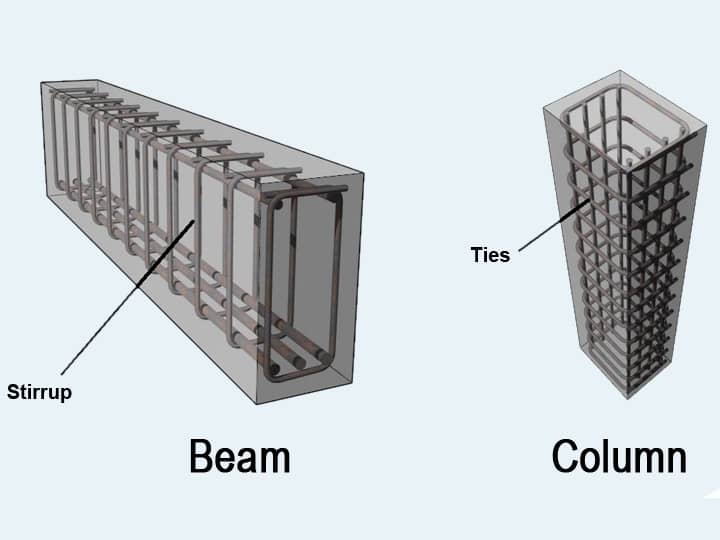Beams are indispensable in building construction these days, and they take up the whole load of the slab. This produces a lot of tension in the beam. There are two kinds of forces acting, mainly - flexural and shearing. To fight these forces, we use reinforcement bars and stirrups. It's clear why we use rebars - but why do we use stirrups in construction?
There are two kinds of steel reinforcements in an RCC beam - longitudinal thick steel bars placed along the length, and bars of smaller diameter looped around the long bars placed at strategic intervals. And the two kinds of failures that may happen in a beam are bending failure due to flexural forces, and shearing failure.
Under the weight of the floor and wall on top of it, a beam may bend downward, or "sag". This is flexural failure and the longitudinal bars are there to stop this from happening. However, they are not much help when they encounter shearing forces.
When a beam undergoes both shearing and flexural forces, the bar wants to sag or bend downwards. This causes stretching at the bottom of the beam, and compression at the topside of the beam. The stretching at the bottom side will work negatively and try to create cracks there. It happens most at the midsection of the beam, and makes the beam very brittle - thereby compromising the safety of everything being supported by that beam.
To prevent this, we may use stirrups. Stirrups resist the shearing action and act as a preventive measure against the long bars getting bent. A similar kind of reinforcement is used in columns as well, but they are called "ties" in that case.
A stirrup is generally a small-diameter steel bar ? no. 3 or no. 4 in most cases. It is bent into a rectangular shape to fit snugly around the horizontal bars and hold them in place. They can be "open" or "closed" depending upon how they are tied at the ends - can leave the ends open biasing the protection to one side, or you can make a closed loop of the thin bar to provide all-around protection.
There is a test of strength for the concrete beams, called uniaxial compression test. In this test, at the end when the stress on a concrete cube reaches the ultimate failure point, vertical cracks appear on the surface and it starts to split up. This happens because the concrete is forced to stretch towards the sides. However, it was observed that if the concrete is "tied up" in lateral directions, then it can't stretch as much and so these cracks will be prevented until much greater loads.
So, there's your reason to provide stirrups. It ties up the concrete in side-to-side, and so the concrete can't stretch and can't break. They can keep this up for a great amount of load. This increases the beam's strength, as well as the final failure strain value.
This idea is excellent when designing bridge columns. As a long, thin structure, a bridge faces a lot of shearing strain, especially in bad weather. Stirrups, or ties as they are called in this case, are provided around the vertical reinforcement bars at regular intervals to fight that force. It also helps to protect the internal core concrete from vertical deformation. This ends up in much stronger columns than one made without ties.
Open stirrups are the best if you aren't facing much torsional forces at that point of beam. They are great at resisting shear forces. These U-shaped stirrups are placed in such a way that the bottom of the U is at the side of the beam where you're expecting the cracks to appear most.
However, that's not a great idea where you are expecting lots of torsional forces on a point. In such cases, you have to use a closed stirrup to provide protection from all sides.
To be honest, reinforced cement concrete beams are plenty strong by themselves. They provide some good shear capacity. However, for that to be in effect, the beam has to be quite thick - which is both ineffective at cost and space economy. If the beam cannot be deep enough to supply enough shear strength by itself - for any reason - then you have to install stirrups to increase the shear capacity of the beam.
It isn't a good idea to make stirrups on-site after the bars are already in place. Often this sounds like a good idea since the stirrup is constructed from two pieces with inadequate lap splice. However, it is both easier and efficient to install the stirrup at the same time when the bars are being installed as well.
